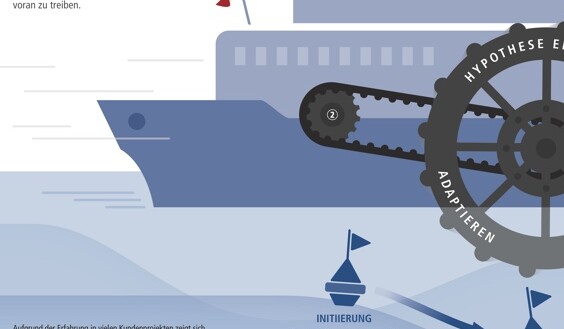Modernisation
Unlocking the potential of modernisation
There is enormous potential in modernising software, from improving performance, security and quality to enabling new business ideas. New methods also open the door to significantly more efficient business processes and the development of new services. Make your software fit for the future!
Your Benefits
- Quality and stability: Resolve existing quality and stability issues and bring the user interface up to date.
- Enormous potential: Improve the performance, security and quality of your software and develop new business ideas. Migrate legacy systems to the cloud, maintain and evolve existing applications, and integrate mobile applications.
- Efficient business processes: Use modern methods to streamline your business processes and create new services.
- Adaptable software: Benefit from our expertise in modernising your software so that it can flexibly adapt to changing business and user requirements.
- Future-proof solutions: Prepare for the future and avoid costly patchwork solutions by modernising your software in a targeted manner or developing it from scratch.
Rolf Traber, CEO, mms solutions ag
bbv helped us to modernise our software to deliver a highly flexible system. We benefited enormously from the know-how of the different experts at bbv.
Our Services
- Architecture Modernisation: Where necessary, we modernise the software architecture to provide the flexibility to make rapid adjustments and continuous improvements to your software in the future.
- Software Modernisation Workshops: Here we show you exactly what strategies and options are available to modernise your software – and give you a recommendation for implementation at the end of each workshop.
- Potential analysis: Our experts identify the modernisation potential of your software and suggest appropriate improvements.
- Gentle modernisation or partial replacement: We analyse your software in a fair and open way and recommend a soft modernisation or a modularised partial replacement, depending on the situation.
- Complete redevelopment: If necessary, we will recommend a complete redevelopment of your software. In the case of a new development, we use quality assurance measures to ensure consistent functionality during the transformation.
- Minimally invasive refactoring: We focus on those components of your software that urgently need to be adapted to increase development speed.
Software Modernisation
Workshop Series
Choose your individual workshop: Here we show you specific strategies and options for modernising your software. Tailored to your situation and business, we will provide you with an implementation recommendation at the end of each workshop.

Christian Königsdorfer, Manager and Co-Owner of proles solutions ag
We called on bbv to help us implement future innovations faster in our software. The cooperation with bbv was top class – both technically and personally.
Are you looking to unlock the potential of software modernisation for your business?
Then let us talk!
What is the difference between software modernisation and software migration?
Although the terms software modernisation and software migration are often used interchangeably, strictly speaking there are differences. While software modernisation is about revising and improving the existing system, software migration is about moving to a completely new platform or technology. Both approaches have their advantages and disadvantages.
We will be happy to advise you on which strategy is best suited to your organisation.
Can I partially modernise my existing software?
Yes, partial modernisation is usually possible and is often a cost-effective way to improve the performance and security of your software.
You can read more about this in our blog post «Why software modernisation is often the best solution» (in German).
How do I measure the success of software modernisation?
The success of software modernisation can be measured using various KPIs and indicators. Some KPIs for measuring success are listed below:
- Performance improvement: Monitoring system performance before and after modernisation to determine if there are improvements in performance, reliability and efficiency
- Cost savings: Analysing operating costs before and after the modernisation to determine if the modernisation has resulted in cost savings.
- User satisfaction: Conducting user surveys or analysing user feedback to assess the impact of the modernisation on the user experience.
- Security improvements: Reviewing security protocols and measures to determine if the modernisation has improved system security.
- Scalability: Evaluate the system’s ability to handle increasing demands as an indicator of successful modernisation.
- ROI (Return on Investment): Calculating the ROI by comparing the cost of modernisation with the benefits achieved to assess the economic viability of the project.
- Economic objectives: Checking whether the modernisation has helped to achieve specific business objectives, such as increased sales, improved customer loyalty or new product launches.



